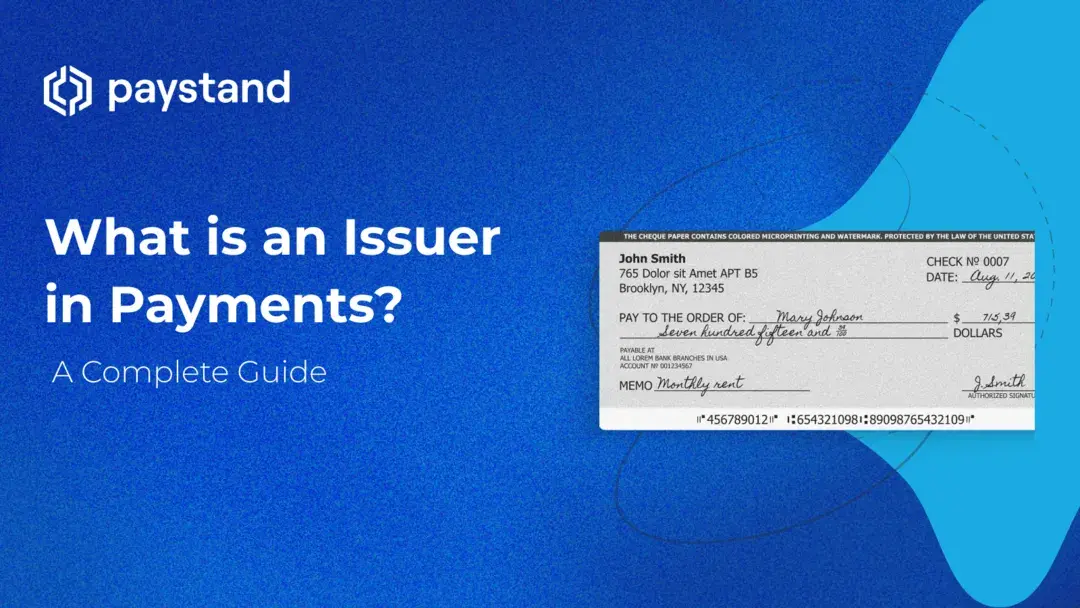What is an Issuer in Payments? A Complete Guide

Table of Contents
- What Is an Issuer in Payments?
- How Issuers Work
- Types of Issuers
- What Is an Acquirer?
- Optimize Your Payments Strategy with Paystand
Key Takeaways:
- An issuer is a bank or financial institution providing payment cards to consumers, authorizing transactions, and managing credit risk to ensure secure payments.
- Issuers include large banks, credit unions, and fintech companies, each offering distinct features and tailored customer support.
- Paystand’s fee-less B2B payment network helps businesses lower transaction costs, enhance cash flow, and streamline payment efficiency across their supply chains.
- The issuer plays a pivotal role in digital payment systems, especially for businesses navigating transactions with banks, credit card companies, and financial institutions.
As card usage rises globally, credit card purchase volume reached $19.6 trillion in 2023, a 3.5% increase from the prior year, and debit card purchase volume was at $17.725 trillion, up 8.6% from 2022. These trends highlight the increasing importance of understanding issuers in digital payments to maximize efficiency and ensure secure transaction processes.
This article explores issuers' roles, types, functions, and security standards—providing a strategic advantage for businesses seeking a comprehensive digital payments strategy.
What Is an Issuer in Payments?
In finance, an issuer is an entity, typically a bank or financial institution, that provides and authorizes payment cards like credit or debit cards. Major issuers, including Chase, Bank of America, and Capital One, collectively manage billions in consumer credit and support millions of transactions daily.
In the context of payments, an issuer (or issuing bank) is responsible for issuing credit or debit cards to customers, representing the customer side in each payment transaction. Issuers manage aspects like credit limits, transaction approval, and security. According to the Federal Reserve, issuers assess credit risks and ensure the transaction’s security, making this role critical in digital payments and traditional banking systems.
For example, when a customer uses their card, the issuer evaluates their account to confirm funds or credit availability. This process includes fraud prevention checks and authorization approvals to secure the transaction.
How Issuers Work
In a typical payment transaction, the issuer undertakes several steps to protect both the consumer and the business:
- Transaction Authorization: Issuers receive requests to authorize transactions and evaluate the cardholder's available credit or funds.
- Approval Process: The issuer reviews the cardholder’s account, credit limits, and transaction history before approving or declining the payment.
- Risk Management: By adjusting credit limits based on financial profiles, issuers maintain manageable exposure to risk.
- Dispute Handling: Issuers oversee chargebacks, evaluating and managing disputes when a customer contests a charge.
Types of Issuers
- Bank Issuers: Large banks offer credit and debit cards, set interest rates and credit limits, and provide customer support.
- Credit Unions: Credit unions focus on their members and often offer lower fees and favorable interest rates than traditional banks.
- Fintech and Non-Bank Issuers: Fintech companies partner with banks to deliver digital-first payment solutions, catering to customers with enhanced mobile and app-based features.
What Is an Acquirer?
Whereas issuers represent the customer in transactions, acquirers (or acquiring banks) work on behalf of the business. Acquirers help businesses collect payments by securing funds from the issuer and transferring them to the merchant.
Companies like Paystand streamline this process, leveraging blockchain-based, fee-less payments that eliminate costly credit card fees and simplify the payment lifecycle for B2B transactions.
Optimize Your Payments Strategy with Paystand
Paystand’s unique approach optimizes the roles of both issuers and acquirers by providing a fee-less B2B payment network that eliminates fees per transaction. This system enables businesses to seamlessly adopt digital payments–benefitting both the merchant and their customers with an improved customer experience and faster time to cash. With Paystand’s tools, companies can reduce transaction costs, enhance financial transparency, and simplify the reconciliation process across their supply chains.
Understanding the distinct roles of issuers and acquirers empowers businesses to streamline their payment processes, reduce costs, and boost security. To gain a competitive edge with digital payments, download our eBook, “The Competitive Advantage of Digital Payments in Your Supply Chain.”







